Passion fruit vines are incredibly easy to grow in Australia, with just a touch of attention, and occasional feeding. Growing your own passion fruits is a great way to enjoy fresh, juicy fruit at home.
In this article, we will cover everything you need to know about growing passion fruit vines, including propagation, care, pests, and diseases.
More...

Family: | Passifloraceae |
|---|---|
Genus: | Passiflora |
Species: | P. edulis |
Common Name: | Passion Fruit Vine |
Origin: | Native to South America |
Location: | Outdoor |
Type: | Fruiting vine |
Growth: | 6 metre vines |
Sun requirements: | Full sun to partial shade |
Foliage Colour: | Dark green |
Flower Colour: | White, pink, or purple |
Flowering: | Winter to Spring |
Edible Parts: | Small yellow or purple fruit (usually edible) |
Maintenance level: | Medium |
Poisonous for pets: | Fruit is not toxic, but foliage and stems can cause gastrointestinal upset |
Introducting Passion Fruit Vines
The passion fruit vine (Passiflora edulis) is a climbing vine that belongs to the Passifloraceae family. This vine is native to South America and is widely grown for its edible fruit.
Passion fruit vines can grow up to 10 metres long and produce large, deeply lobed, and attractive leaves, making them just as useful as ornamental plants, as productive crops.

Passion fruit flowers come in different colours depending on the variety, but typically emerge as white, and open out into strikingly architectural star-shaped, with deep centres surrounded by geometric blue markings.
The fruit produced by the vine is round or oval and varies in size, from that of a golf ball to that of a grapefruit. The fruit has a hard outer shell that contains a juicy, yellow, or orange-coloured pulp that is rich in flavour.
Natural Habitat of Passiflora edulis
Passion fruit vines are native to tropical parts of South America, but thanks to commercial cultivation and horticultural collections, can be found in many parts of the world, including Asia, Australia, Africa, and North America.
Passion fruit vines grow best in warm, humid climates with well-draining soils. They can tolerate a wide range of soils but do best in slightly acidic soils (pH of 6 to 7.5).
Best Passion Fruit Varieties to Grow in Australia
There are four basic groups of passion fruits, and all grow largely in the same way, with slightly acidic soil, on moisture-retaining compost. The four types, which we’ll talk about in more detail below, are; purple passion fruit, yellow passion fruit, sweet granadilla, and giant granadilla.
By far the easiest to grow, and most common, are purple passion fruit, which you’ll find in most grocery shops too, but yellow passion fruit has a more distinct flavour and can be well worth trying.
For me though, if you can feed it well, and give it the right conditions, sweet granadilla is the most rewarding treat to grow.
1. Purple Passion Fruit (Passiflora edulis)
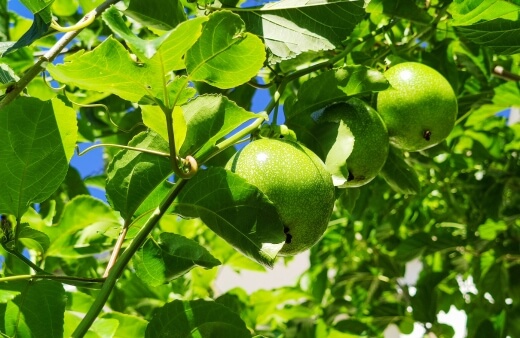
The flowers of purple passion fruit vines are instantly recognisable, with frilled edges, and dramatic anthers. They are incredibly simple to grow, and cling seamlessly to almost any support.
Their fruits are milder than others, but because they are easier to grow (any rich compost in a pot, or enriched garden soil will do) they are a great variety for beginners and season growers alike.
When they ripen they have a deep purple skin, that can be harvested while the skin is smooth, and eaten when it begins to wrinkle for a sweeter flavour.
2. Yellow Passion Fruit (Passiflora flavicarpa)
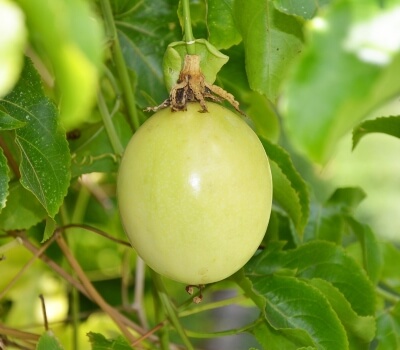
Source: Trade Winds Fruit
Yellow passion fruits need to be squeezed to know when they're ripe, as they develop as young, green seed pods, and swell into yellow fruits, but won’t be fully ripe for a week or two after they reach full size. Their skins remain smooth off the vine too and can be eaten straight away.
The flavour is more distinct and has an unusual creamy bitterness. However, while they are more vigorous and establish faster, they require quite a strict watering regimen to get a successful harvest.
I suggest weekly water of about 3 litres, right at the roots, increased to twice a week in summer, and daily in very warm spells. Every year, mulch them heavily with organic materials around the base of the plant too.
3. Sweet Granadilla (Passiflora ligularis)

Sweet Granadilla is, if you can get it right, a really spectacular fruit, with golden-orange skins, and a generous filling of sweet flesh and edible seeds.
The flowers are unusual too, with striped markings on each petal. While it’s called sweet granadilla, it still has the astringent sourness of passion fruits, but with a gentler aftertaste.
If you’ve grown purple passion fruit successfully, try your hand at these gorgeously refreshing summer fruits this year.
4. Giant Granadilla (Passiflora quadrangularis)

Giant Granadilla, or giant passion fruits are much harder to grow, simply because the fruits require support when they reach maturity, and can be roughly the size of a melon.
Their seeds and flesh are less generous though, as the skins are thicker, and tend to ripen to green or yellow-green, with not much to eat.
If you’re growing them to show off though, this is definitely the passion fruit for you, but be sure to use sturdy trellis, and consider hooking old net grocery bags around the developing fruits to take their weight, and take pressure off the vines.
How to Grow Passion Fruit Vine
Getting started with passion fruits means preparing your soil, or at least testing it. If you just want to grow attractive vines, with stunning flowers, you can get away with most conditions.
But if you plan on harvesting their sweet, juicy, fruits, you’ll need to make sure the soil is just slightly acidic, and packed with moisture-retaining materials like compost, leaf mould, or manure before planting.
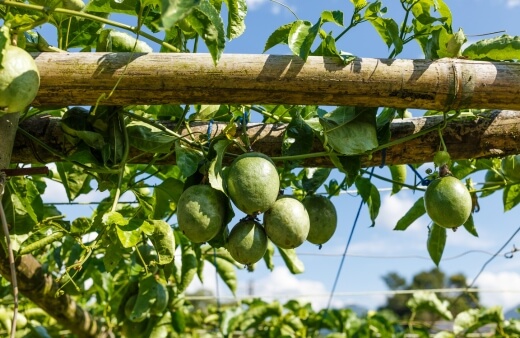
Best Conditions for Planting Passion Fruit
Light & Temperature
Passion fruit vine requires full sunlight to thrive and produce fruit. Passion fruit can tolerate some shade, but it is best to plant it in an area with at least 6 hours of sunlight daily.
Passion fruit vines also prefer warm temperatures, and they can only tolerate light frosts. In areas with cold winters, it is best to plant the vine in a sheltered area, such as against a south-facing wall.
Soil & Drainage
Passion fruit vines grow best in well-draining soils with a pH of 6 to 7.5. The soil should be rich in organic matter and nutrients to support the growth of the vine.
Before planting, it is recommended to mix compost or well-rotted manure into the soil. The vine prefers slightly acidic soil, so adding sulphur to the soil can help lower the pH.
Trellis & Supports
Passion fruit vines are climbers and require support to grow. Any standard trellis, twine, or wire supports are ideal to support the weight of the vine (particularly while fruiting).
Personally, I love to grow passion fruit against walls and fences, which makes support even easier. Just secure hooks at either side of the vertical structure and run through galvanised wire from one side to the other.
Place horizontal wires two feet above each other to allow the vines to cling on as they stretch upwards.
10 Passion Fruit Vines Trellis Ideas
1. Wires and eyelets
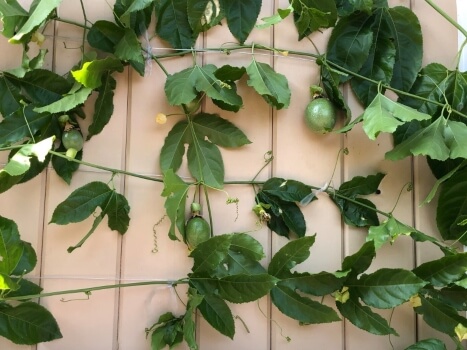
Source: UC ANR
The easiest way to train your passion fruit, and perhaps one of the most impressive, is to treat it as a wall-climber, using wires and eyelet hooks.
Simply screw eye hooks into your wall (this works on masonry or timber cladding, and even on fences too), secure galvanised wire between them, making sure the wire is supported by an eyelet, roughly every two metres.
Plant your passion fruit in the centre of the wall, with plenty of organic matter, and tie in the first few vines so they spread out like a fan. After a few years, it should naturally sprawl across the wires, making it easy to prune and harvest.
2. Pergolas

Any pergola, or veranda made from timber or metal struts will provide an impressive structure for your passion fruit, but remember, its tendrils can only grab onto materials that are 1cm wide or less, so provide wire or twine for the passionfruit to climb up and get started.
Once it's established, its own vines will provide structure for new tendrils as they form.
3. Chicken wire fence
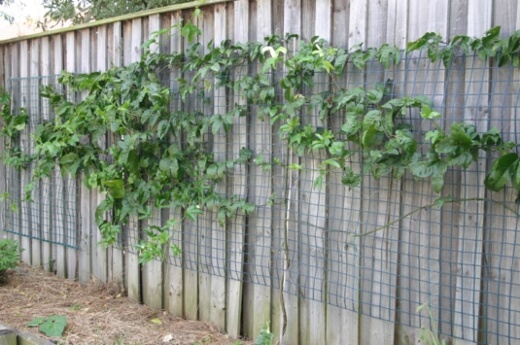
Source: The Veggie Lady
If you don’t fancy drilling permanent holes in your fences or walls, you can secure chicken wire against a fence either with staples or by weaving bamboo through the end of the wire sheet and using it to stake the chicken wire into the ground.
Do this along your fence to create an extra layer, which your passion fruit can easily clamber and vine across, adding a beautiful and easily manageable alternative to climbing ivy to cover up a boring fence.
4. A-Frame supports

Source: Passionfruit Australia
Commercial growers use huge A-frames to grow passion fruits, allowing them to prune inside the frame, and harvest from outside. You can do this on a smaller scale at home by creating a raised bed, packed with rotted manure, compost, and garden soil in equal parts, and building a basic timber frame with a cross beam.
The whole thing takes two hours to set up, and you’ll have a permanent and dedicated growing space for your passion fruits when you’re done.
5. Simple trellis
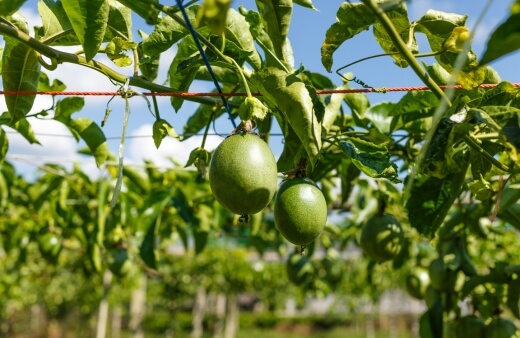
Any store-bought trellis will work as a base for your passionfruit, but make sure you buy one with narrow bars. Passion fruit tendrils can only grab only things that are less than 1 cm across, preferring wire or string to timber posts.
The benefit of a basic timber trellis is that you can add to it, weaving other materials through to create more vining space. For young passion fruits though, any small section of trellis will be enough for vigorous young growth to climb through, but you might need to tie it in occasionally.
6. Post and wire
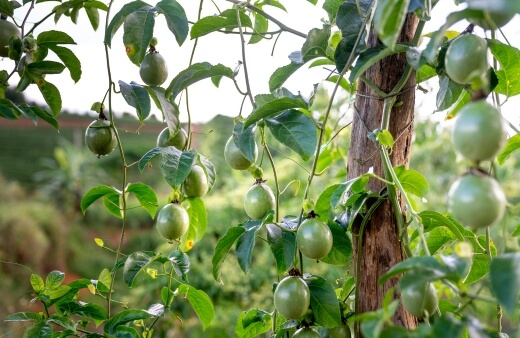
Post and wire systems are ideal for anyone short on space. Rather than creating a huge A-frame, you can cement in two large timber, or metal posts, and run wire tightly between them. This means you can grow passion fruits from one end of the garden to the other, without needing to dedicate huge spaces.
For allotments or dedicated veggie gardens, this is a great way to divide spaces too as the passion fruit will droop, and when it matures, provide screening and dappled shade for other plants.
7. Passion fruit arch
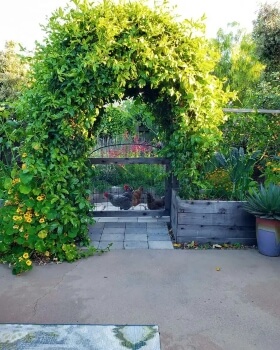
Source: Homestead and Chill
If you’ve got a store-bought arch that’s looking a bit bare, why not grow something that’s both beautiful and productive? Passion fruits provide shade, as well as gorgeous foliage, and stunning flowers, followed by exciting edible fruit.
Adding an arch to your garden and covering it with passion fruit vines is a wonderful way to make the most of your growing space.
8. Passion fruit awning

Source: Pinterest
For anyone looking for a real statement piece of architecture for the garden, look no further than this DIY passion fruit awning, which provides shade in summer, and structure in winter around a simple seating area.
Even if your garden is hard landscaped, you could grow a passion fruit vine in each corner in a large plastic pot, feeding it fortnightly to boost flowering and fruit. You’ll be rewarded with a stunning central seating area that provides shade and food.
9. Passion fruits in pots
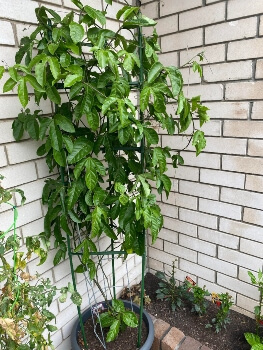
Source: r/gardening
If you keep a balcony garden, don’t let that limit you. If you find a big enough pot and fill it with rich organic materials like compost, manure, or even garden soil enriched with slow-release fertilisers, you can grow spectacular passion fruits.
If you do grow passion fruits on a balcony, they can climb and send vines through the balcony fencing, or you can add a simple trellis to your pot like this one to get it started.
10. Passion fruits along fences
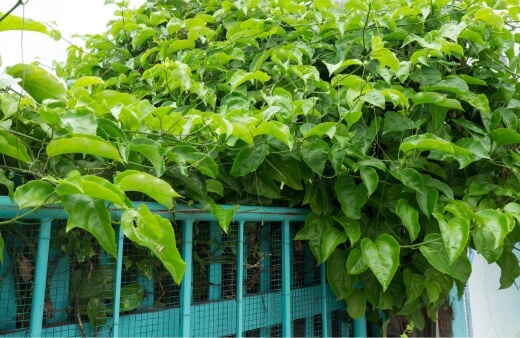
Any fence can be a passion fruit support, especially open fences like this, which look a hundred times better with some greenery growing through them. Add a cheap plastic mech, or basic chicken wire along the length of the fence to provide interest from every angle.
How to Propagate Passion Fruit Vine
Propagating Passion Fruit Vine from Seeds
Passion fruit vines can be propagated easily from seed, whether you’re trying to save seed from fruits, or grow them from packaged and dried seeds.
To grow passion fruit vines from saved seed:
- Remove the seeds from the fruit and rinse them with water.
- Sow three to four seeds in a 10cm pot-filled seed compost (or make your own with 50% sand and 50% sieved compost)
- Place it in a warm, well-lit area.
- Keep the soil moist, and the seedlings should germinate within 2-3 weeks.
- Once the seedlings reach 15-20cm, they can be transplanted into their permanent location.
Passion Fruit Vine Propagation from Cuttings
Propagating passion fruit vines from cuttings can be a slightly faster way to produce fruiting plants. Take a 10-15cm cutting from the parent plant in mid-spring, but before the cutting has any signs of flowers or buds.
Make sure the cutting has at least two leaf nodes. Then simply dip the cutting into rooting hormone and plant it into a pot with a 50/50 mix of compost and perlite for drainage.
Cover the pot with a plastic bag to retain humidity, and place it somewhere warm and bright, but out of direct afternoon sun. After 4-6 weeks you should have a well-rooted cutting that can be planted out, or grown on until next spring.
Caring for Passion Fruit Vines
Passion fruit vines are known for their beautiful flowers and delicious fruits, but to ensure a healthy plant, proper care is essential. Here are some important tips for caring for passion fruit vines.
Mulching
Mulching is essential to keep the soil moist, suppress weeds, and provide nutrients. A layer of organic mulch such as straw, leaves, or grass clippings can be spread around the base of the plant.
The mulch should be kept a few inches away from the trunk to prevent excess moisture and disease.
Passion Fruit Vine Fertiliser
Passion fruit vines require regular feeding to produce vigorous growth and a good crop of fruit. Any balanced fertiliser like tomato feed or a homemade comfrey feed, can be applied once a month during the growing season, but I’d suggest organic liquid seaweed, and boost feeding to once every two weeks after flowering.
Repotting
If you grow passion fruits in pots, which is often necessary on very sandy soils, they will outgrow their pots every 3-4 years. To repot, gently remove the plant from its pot and tease apart any tangled roots. Place the plant in a slightly larger pot with fresh compost and water thoroughly.
Pruning Passion Fruit Vines
Pruning is essential to keep passion fruit vines tidy and to promote better fruiting. Passion fruits should be pruned in early spring before new growth emerges, similar to most climbing vines, as the flowers and fruits are produced on fresh new growth.
Every two years, it’s worth cutting half the plant right back to the ground, then alternating two years later with the other half. This will stop your passion fruit from developing a woody base, and allow you to harvest fruits lower down too.
Harvesting and Storing Passion Fruits
Passion fruits are ready to eat when they are slightly wrinkled, indicating that the flesh has broken down into a sweet, sugary mix of flesh and seeds, but that's not necessarily when they’re ready to harvest!
Thankfully though, that unique trait does allow you to store them for longer than you might think, and leave you with plenty of time to decide exactly what to do with them when you’re ready.

When is passion fruit ready for harvest?
If you’ve never grown passion fruit before, you might be surprised that passion fruit is ready to harvest when it’s plump and smooth, not when it's wrinkled and rich in colour.
The most common type of passion fruit - purple passion fruit - is ready to harvest when its skin is deep purple, but not quite fully black, and it slightly compresses under pressure.
Once it feels ripe, try twisting it from the vine gently; it should pull off quite easily, indicating it’s ready for storing - but not quite ready for eating.
How to store passion fruit
After harvesting, store your passion fruits at room temperature for about a week, when they will begin to wrinkle and the skin will harden. The flesh inside will soften during this time, and produce a much sweeter fruit.
If you leave passion fruits on the vine for too long, the same thing will happen, but the seeds will develop and become too big to eat, or at least to enjoy.
At room temperature (in a fruit bowl, or on the counter) passion fruit keeps for about a week after it ripens. Once ripe though, they can keep for nearly a month, if not longer in the fridge, in an air-tight plastic bag.
Personally, I’ve never harvested a passion fruit and needed to test that, because as soon as it's ripe, and the skin has begun to wrinkle, it’s usually eaten in a matter of seconds.
If you have a real glut of passion fruits (which is very possible, particularly with a well-fed yellow passion fruit variety), then you can scoop out the insides and freeze them in ice cube trays, or an ice cream tub.
This makes a perfect ingredient for blended cocktails and smoothies at any time of year.
Passion Fruit Vine Pests and Diseases
Passion fruit vines are susceptible to most common garden pests, but also have a few species-specific bugs that like to feed on their leaves, vines, and fruits.
To control pests on passion fruit, it’s important to stick to organic treatments like insecticidal soap or neem oil. You can also use natural predators like ladybugs, but essentially, if you’re going to eat it, stick to organic products. If it’s not good for bugs, it’s probably not good for you.
Passionfruit vine hopper
The passionfruit vine hopper is a common pest that can cause severe damage to passion fruit vines. The insect feeds on the plant sap, causing leaf yellowing and leaf drop.
It also secretes honeydew which promotes the growth of sooty mould, which can further damage the plant, as well as attracting ants.
Spider mites
Spider mites are tiny pests (typically less than 0.2mm across, with brown, white, or red bodies) that can cause significant damage to passion fruit vines. They suck the sap out of the leaves, causing them to turn yellow before falling from the plant.
Spider mites are more common in hot and dry weather conditions. Find out more about spider mites here.
Scale insects
Scale insects are another common pest that can attack passion fruit vines. They feed on sap and excrete honeydew, which can lead to the growth of sooty mould.
The scales are often found on the undersides of leaves, and can cause the leaves to turn yellow and drop prematurely. Find out how to deal with scale insects here.
Passion fruit vines are also susceptible to a variety of diseases that can affect the plant's growth and fruit production. To control diseases, it's important to maintain proper plant hygiene and sanitation, including regularly removing fallen leaves, cleaning secateurs and shears, and avoiding overwatering.
Fusarium wilt
Fusarium wilt is a fungal disease that affects roots, before the leaves turn yellow and wilt. The disease is spread through contaminated soil, water, and tools, but can be treated with copper fungicides.
Phytophthora root rot
Phytophthora root rot is a fungal disease that affects the roots of the plant. It causes the plant to wilt and die, and can be spread through contaminated soil, water, and plant debris.
Bacterial spot
Bacterial spot is a bacterial disease that affects the leaves and fruits of the plant. It causes dark spots on the leaves and fruit, and can cause the fruit to become deformed and drop prematurely.
Passion Fruit Vine Frequently Asked Questions

When is the best time to plant passion fruit vines?
The best time to plant passion fruit vines is early spring. Not only will this avoid the risk of frost in colder parts of Australia, but it makes the most of the growing season, as your vines will be leaving dormancy, and entering active growth just as you place them into the ground.
How long does it take for a passion fruit vine to bear fruit?
It typically takes 1-2 years for a passion fruit vine to begin producing fruit after planting. From seed, passion fruits will rarely produce fruit in their first four years, and it’s best to remove young fruits before they develop for the first few years anyway, to encourage a focus on vine and root production.
How often should I water my passion fruit vine?
Passion fruit vines should be watered about once a week, or when the top inch of soil feels dry. Through summer, this should be increased to twice a week if there is no rainfall and stopped completely through winter.
Can passion fruit vines be grown indoors?
While passion fruit vines can be grown indoors, they do require a lot of sunlight and space to grow, and outdoor ventilation helps to reduce fungal problems, so if you do grow them indoors, water them regularly, feed them more often, and make sure they are properly ventilated.
Wrapping Up Our Passion Fruit Vines Growing and Caring Guide
Growing passion fruit vines can be a rewarding experience for any gardener, and even if you’re not much of a green thumb yourself, they will nearly always perform well as ornamental vines.
But, by providing the right growing conditions and care, you can enjoy a huge harvest of delicious fruit. Just remember to choose a sunny location, provide proper drainage, and support the vine with a trellis or support.
With those simple tips, you’ll be harvesting your own flavour-packed fruit, from backyard passion fruit vines in no time.
Published on May 14, 2023 by Maisie Blevins
Last Updated on February 23, 2024




